EPA风险评估模型(英文)
- 格式:ppt
- 大小:3.79 MB
- 文档页数:49
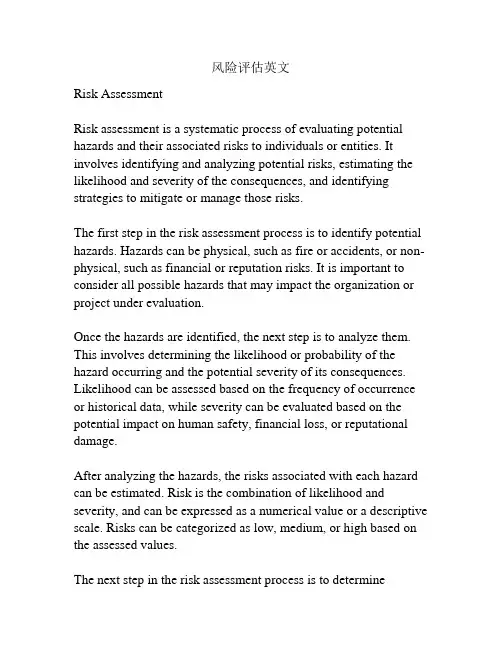
风险评估英文Risk AssessmentRisk assessment is a systematic process of evaluating potential hazards and their associated risks to individuals or entities. It involves identifying and analyzing potential risks, estimating the likelihood and severity of the consequences, and identifying strategies to mitigate or manage those risks.The first step in the risk assessment process is to identify potential hazards. Hazards can be physical, such as fire or accidents, or non-physical, such as financial or reputation risks. It is important to consider all possible hazards that may impact the organization or project under evaluation.Once the hazards are identified, the next step is to analyze them. This involves determining the likelihood or probability of the hazard occurring and the potential severity of its consequences. Likelihood can be assessed based on the frequency of occurrence or historical data, while severity can be evaluated based on the potential impact on human safety, financial loss, or reputational damage.After analyzing the hazards, the risks associated with each hazard can be estimated. Risk is the combination of likelihood and severity, and can be expressed as a numerical value or a descriptive scale. Risks can be categorized as low, medium, or high based on the assessed values.The next step in the risk assessment process is to determineappropriate strategies to manage or mitigate the identified risks. This may involve implementing control measures, such as safety protocols or insurance policies, to reduce the likelihood or severity of the hazards. It is important to prioritize the risks based on their likelihood and severity, and allocate resources accordingly.Finally, it is necessary to continually monitor and review the effectiveness of the risk management strategies. Risk assessment is an ongoing process, and it is important to adapt and modify the risk management strategies as new information becomes available or as the organization or project evolves.In conclusion, risk assessment is a crucial process in identifying and managing potential hazards and risks. It involves a systematic approach of identifying hazards, analyzing risks, estimating likelihood and severity, and implementing appropriate strategies to mitigate or manage the risks. By conducting effective risk assessments, organizations and individuals can proactively identify and address potential risks, minimizing the likelihood and impact of adverse events.。
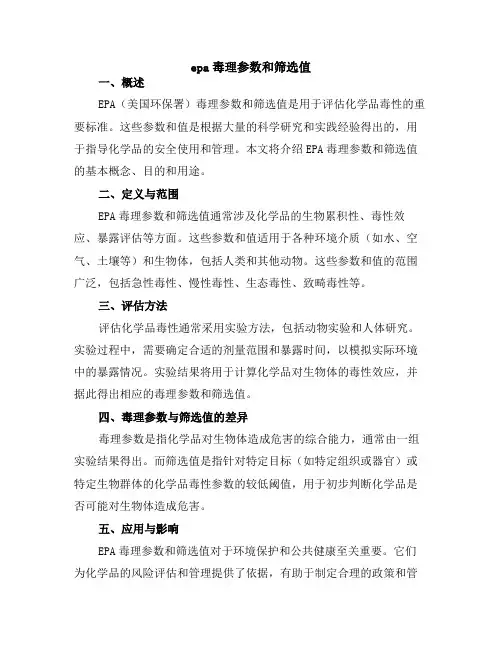
epa毒理参数和筛选值一、概述EPA(美国环保署)毒理参数和筛选值是用于评估化学品毒性的重要标准。
这些参数和值是根据大量的科学研究和实践经验得出的,用于指导化学品的安全使用和管理。
本文将介绍EPA毒理参数和筛选值的基本概念、目的和用途。
二、定义与范围EPA毒理参数和筛选值通常涉及化学品的生物累积性、毒性效应、暴露评估等方面。
这些参数和值适用于各种环境介质(如水、空气、土壤等)和生物体,包括人类和其他动物。
这些参数和值的范围广泛,包括急性毒性、慢性毒性、生态毒性、致畸毒性等。
三、评估方法评估化学品毒性通常采用实验方法,包括动物实验和人体研究。
实验过程中,需要确定合适的剂量范围和暴露时间,以模拟实际环境中的暴露情况。
实验结果将用于计算化学品对生物体的毒性效应,并据此得出相应的毒理参数和筛选值。
四、毒理参数与筛选值的差异毒理参数是指化学品对生物体造成危害的综合能力,通常由一组实验结果得出。
而筛选值是指针对特定目标(如特定组织或器官)或特定生物群体的化学品毒性参数的较低阈值,用于初步判断化学品是否可能对生物体造成危害。
五、应用与影响EPA毒理参数和筛选值对于环境保护和公共健康至关重要。
它们为化学品的风险评估和管理提供了依据,有助于制定合理的政策和管理措施,确保公共安全和生态环境不受损害。
此外,这些参数和值也为科研人员提供了研究化学品毒性的基础数据,有助于推动毒理学研究的发展。
六、结论EPA毒理参数和筛选值是评估化学品毒性的重要标准,涵盖了广泛的化学品和环境介质。
通过实验方法和科学研究,这些参数和值被用来评估化学品的综合毒性,并确定较低的阈值用于初步判断化学品是否可能对生物体造成危害。
这些参数和值对于环境保护和公共健康至关重要,为化学品的风险评估和管理提供了依据,有助于制定合理的政策和管理措施,确保公共安全和生态环境不受损害。
七、建议与展望为了更好地应对化学品对环境和人类健康的威胁,建议加强毒理学研究,提高毒理参数和筛选值的准确性和适用性。
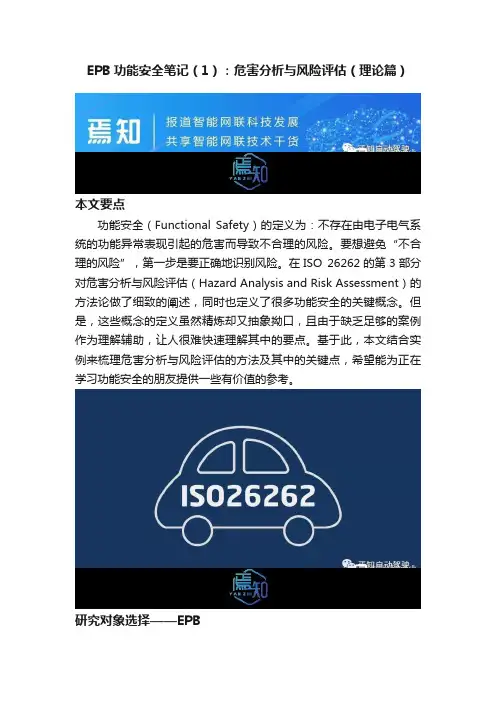
EPB功能安全笔记(1):危害分析与风险评估(理论篇)本文要点功能安全(Functional Safety)的定义为:不存在由电子电气系统的功能异常表现引起的危害而导致不合理的风险。
要想避免“不合理的风险”,第一步是要正确地识别风险。
在ISO 26262的第3部分对危害分析与风险评估(Hazard Analysis and Risk Assessment)的方法论做了细致的阐述,同时也定义了很多功能安全的关键概念。
但是,这些概念的定义虽然精炼却又抽象拗口,且由于缺乏足够的案例作为理解辅助,让人很难快速理解其中的要点。
基于此,本文结合实例来梳理危害分析与风险评估的方法及其中的关键点,希望能为正在学习功能安全的朋友提供一些有价值的参考。
研究对象选择——EPB从功能安全开发流程上讲,相关项定义(Item Definition)是功能安全开发的第一步,其主要目的是明确研究对象的功能、接口以及边界。
为了方便后续对危害分析与风险评估的相关概念进行说明,本文选取EPB系统(电子驻车系统,Electric Parking Brake)作为研究对象。
EPB,电子驻车系统EPB系统的工作原理与机械式手刹相同, 均是通过制动卡钳与刹车片产生的摩擦力来实现车辆驻车, 只不过控制方式从之前的机械式手刹拉杆变成了电子控制。
EPB系统最基本的功能就是实现临时性和长时间驻车。
另外,在配备了EPB系统的车辆中,由于传统的手刹杆或脚刹杆被电子按钮代替,根据法规要求:车辆制动系统必须能够提供除行车制动系统外第二套装置,通过操作该装置能够使车辆达到至少1.5m/s2的减速度。
对于传统车辆,手刹或脚刹可以实现这个功能,而在配备EPB系统的车辆上,可以通过电控液压制动单元主动建压来实现该减速度。
出于安全考虑,EPB系统的人机交互即电子按钮必须设计成上拉激活而不是按压激活,因为在实际使用过程中按钮可能会错误地被按压,比如把女士把包放在按钮上面而造成EPB系统错误激活。
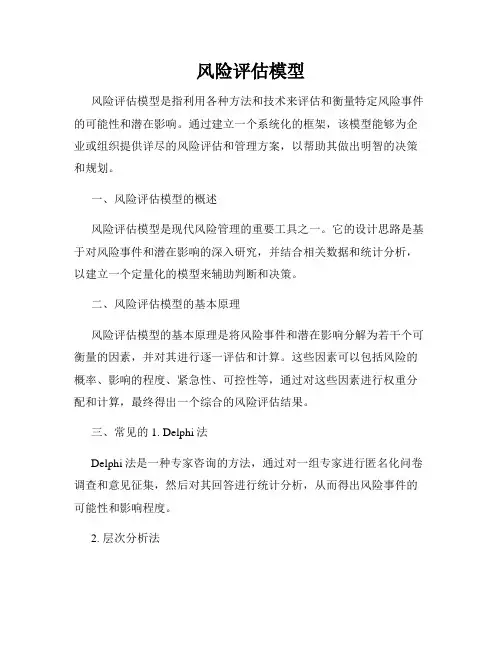
风险评估模型风险评估模型是指利用各种方法和技术来评估和衡量特定风险事件的可能性和潜在影响。
通过建立一个系统化的框架,该模型能够为企业或组织提供详尽的风险评估和管理方案,以帮助其做出明智的决策和规划。
一、风险评估模型的概述风险评估模型是现代风险管理的重要工具之一。
它的设计思路是基于对风险事件和潜在影响的深入研究,并结合相关数据和统计分析,以建立一个定量化的模型来辅助判断和决策。
二、风险评估模型的基本原理风险评估模型的基本原理是将风险事件和潜在影响分解为若干个可衡量的因素,并对其进行逐一评估和计算。
这些因素可以包括风险的概率、影响的程度、紧急性、可控性等,通过对这些因素进行权重分配和计算,最终得出一个综合的风险评估结果。
三、常见的1. Delphi法Delphi法是一种专家咨询的方法,通过对一组专家进行匿名化问卷调查和意见征集,然后对其回答进行统计分析,从而得出风险事件的可能性和影响程度。
2. 层次分析法层次分析法通过将风险事件和潜在影响进行层次化分类,并对每个分类进行比较和评估,最终得出整体风险评估结果。
该方法不仅能够量化风险,还能够提供一种决策支持的工具。
3. 蒙特卡洛模拟法蒙特卡洛模拟法是一种基于概率统计的方法,通过对风险事件和潜在影响的不确定性进行模拟和重复实验,从而得出风险的概率分布和可能范围。
四、风险评估模型的应用领域风险评估模型广泛应用于各个行业和领域。
例如,在金融行业中,风险评估模型能够帮助银行和投资机构量化风险,从而制定有效的风险管理策略。
在项目管理中,风险评估模型能够帮助项目团队识别和评估项目的潜在风险,从而减少项目失败的可能性。
五、风险评估模型的局限性尽管风险评估模型在风险管理中起着重要的作用,但其仍存在一些局限性。
例如,模型的准确性取决于所使用的数据和分析方法的质量,数据的不确定性和偏差可能会导致评估结果的误差。
此外,模型无法考虑到一些特定的因素和情境,需要结合专业知识和经验进行综合评估。
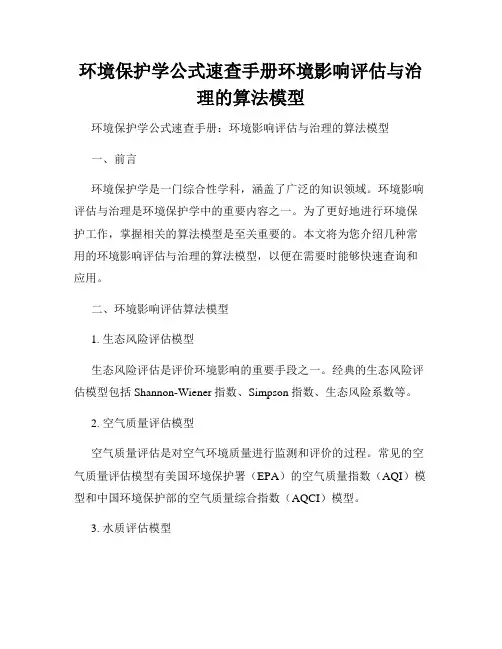
环境保护学公式速查手册环境影响评估与治理的算法模型环境保护学公式速查手册:环境影响评估与治理的算法模型一、前言环境保护学是一门综合性学科,涵盖了广泛的知识领域。
环境影响评估与治理是环境保护学中的重要内容之一。
为了更好地进行环境保护工作,掌握相关的算法模型是至关重要的。
本文将为您介绍几种常用的环境影响评估与治理的算法模型,以便在需要时能够快速查询和应用。
二、环境影响评估算法模型1. 生态风险评估模型生态风险评估是评价环境影响的重要手段之一。
经典的生态风险评估模型包括Shannon-Wiener指数、Simpson指数、生态风险系数等。
2. 空气质量评估模型空气质量评估是对空气环境质量进行监测和评价的过程。
常见的空气质量评估模型有美国环境保护署(EPA)的空气质量指数(AQI)模型和中国环境保护部的空气质量综合指数(AQCI)模型。
3. 水质评估模型水质评估是对水体环境质量进行监测和评价的过程。
常用的水质评估模型包括水质污染指数(WPI)模型、水质干扰排名(DIWR)模型等。
4. 土壤质量评估模型土壤质量评估是对土壤环境质量进行监测和评价的过程。
常见的土壤质量评估模型有土壤环境质量标准(GB 15618-1995)和地质因子法。
三、环境治理算法模型1. 污染物扩散模型污染物扩散模型用于预测和评估不同污染源产生的污染物在环境中的扩散过程。
常见的污染物扩散模型有高斯模型、计算流体力学(CFD)模型等。
2. 修复效果评估模型修复效果评估模型用于评估环境治理措施的实施效果。
常用的修复效果评估模型有环境影响评价修复效果评估模型和生态风险修复效果评估模型。
3. 环境经济模型环境经济模型用于评估环境保护工作的经济效益。
常见的环境经济模型有成本效益分析(CBA)模型和环境影响评价费用效果模型。
四、总结本文介绍了环境影响评估与治理中常用的算法模型,包括生态风险评估模型、空气质量评估模型、水质评估模型、土壤质量评估模型等。
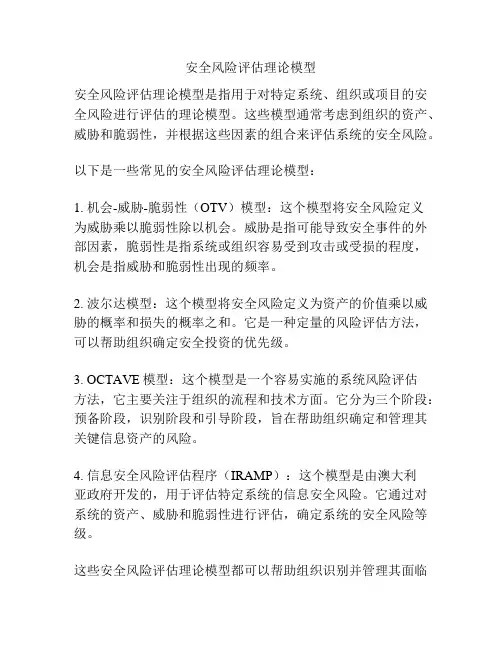
安全风险评估理论模型
安全风险评估理论模型是指用于对特定系统、组织或项目的安全风险进行评估的理论模型。
这些模型通常考虑到组织的资产、威胁和脆弱性,并根据这些因素的组合来评估系统的安全风险。
以下是一些常见的安全风险评估理论模型:
1. 机会-威胁-脆弱性(OTV)模型:这个模型将安全风险定义
为威胁乘以脆弱性除以机会。
威胁是指可能导致安全事件的外部因素,脆弱性是指系统或组织容易受到攻击或受损的程度,机会是指威胁和脆弱性出现的频率。
2. 波尔达模型:这个模型将安全风险定义为资产的价值乘以威胁的概率和损失的概率之和。
它是一种定量的风险评估方法,可以帮助组织确定安全投资的优先级。
3. OCTAVE模型:这个模型是一个容易实施的系统风险评估
方法,它主要关注于组织的流程和技术方面。
它分为三个阶段:预备阶段,识别阶段和引导阶段,旨在帮助组织确定和管理其关键信息资产的风险。
4. 信息安全风险评估程序(IRAMP):这个模型是由澳大利
亚政府开发的,用于评估特定系统的信息安全风险。
它通过对系统的资产、威胁和脆弱性进行评估,确定系统的安全风险等级。
这些安全风险评估理论模型都可以帮助组织识别并管理其面临
的安全风险,从而采取相应的措施保护其关键信息资产。
不同的模型可根据组织的需求和可行性进行选择和应用。

aermod 模型原理及应用AERMOD模型原理及应用一、引言AERMOD(Atmospheric Dispersion Modeling System)是一种用于大气扩散模拟和空气质量评估的模型系统。
它是美国环保署(EPA)开发的一种大气扩散模型,被广泛用于评估工业过程和排放源对周围环境的影响。
本文将介绍AERMOD模型的原理和应用,并探讨其在环境管理和规划中的作用。
二、AERMOD模型原理AERMOD模型基于高斯扩散理论,通过计算源排放物的浓度分布来评估空气质量。
它考虑了大气稳定度、风速、源特征和地形等因素对污染物扩散的影响。
1. 大气稳定度大气稳定度是指大气中温度和湿度的垂直分布情况。
AERMOD模型使用稳定度分类系统将大气分为多个稳定度类别,如非常不稳定、中度稳定等。
这些稳定度类别反映了大气中污染物扩散的能力,从而影响了模型的计算结果。
2. 风速风速是影响污染物扩散的重要因素之一。
AERMOD模型考虑了地面风速和垂直风速剖面的变化,并通过计算源排放物的有效排放高度来估计污染物的扩散。
3. 源特征AERMOD模型考虑了源排放物的特征,如排放速率、温度和高度等。
这些参数对污染物扩散和浓度分布都有重要影响,并被用于计算模型中的各种系数和参数。
4. 地形地形对风速和风向的分布有显著影响,从而影响了污染物的传输和扩散。
AERMOD模型通过引入地形因子来考虑地形的影响,以提高模型的准确性。
三、AERMOD模型应用AERMOD模型在环境管理和规划中有广泛的应用,包括以下几个方面:1. 环境影响评价AERMOD模型可以用于评估工业过程、电厂、道路交通等排放源对周围环境的影响。
通过模拟污染物的扩散和浓度分布,可以预测潜在的环境影响,并为环境管理和规划提供科学依据。
2. 空气质量管理AERMOD模型可以用于评估空气质量,并帮助制定相应的环境管理措施。
通过模拟不同情景下的污染物浓度,可以确定污染源的贡献程度,并制定减排政策和控制措施。
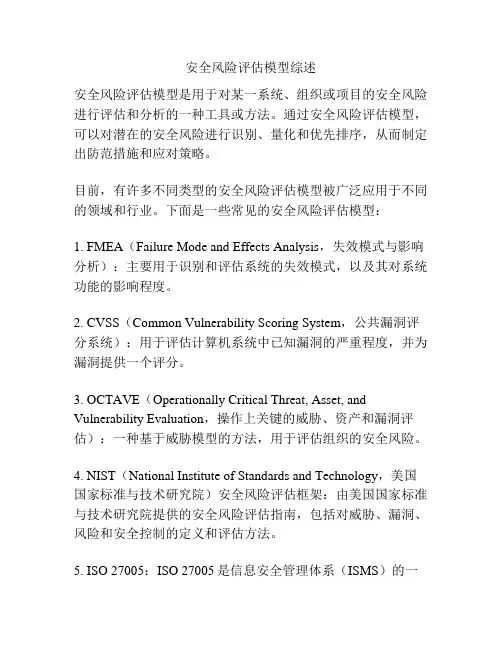
安全风险评估模型综述安全风险评估模型是用于对某一系统、组织或项目的安全风险进行评估和分析的一种工具或方法。
通过安全风险评估模型,可以对潜在的安全风险进行识别、量化和优先排序,从而制定出防范措施和应对策略。
目前,有许多不同类型的安全风险评估模型被广泛应用于不同的领域和行业。
下面是一些常见的安全风险评估模型:1. FMEA(Failure Mode and Effects Analysis,失效模式与影响分析):主要用于识别和评估系统的失效模式,以及其对系统功能的影响程度。
2. CVSS(Common Vulnerability Scoring System,公共漏洞评分系统):用于评估计算机系统中已知漏洞的严重程度,并为漏洞提供一个评分。
3. OCTAVE(Operationally Critical Threat, Asset, and Vulnerability Evaluation,操作上关键的威胁、资产和漏洞评估):一种基于威胁模型的方法,用于评估组织的安全风险。
4. NIST(National Institute of Standards and Technology,美国国家标准与技术研究院)安全风险评估框架:由美国国家标准与技术研究院提供的安全风险评估指南,包括对威胁、漏洞、风险和安全控制的定义和评估方法。
5. ISO 27005:ISO 27005是信息安全管理体系(ISMS)的一部分,提供了一种基于风险评估和风险处理的安全管理框架。
除了以上提到的模型外,还有许多其他的安全风险评估模型,如RAMP(Risk Analysis and Management for Projects),HIRARC(Hazard Identification, Risk Assessment and Risk Control),以及多层次模糊综合评估等。
需要注意的是,每个模型都有其特定的应用领域和适用范围,选择适合自己需求的模型进行安全风险评估是很重要的。

calpuff模型概述
CALPUFF模型是一种大气扩散模型,用于评估大气污染物在空气中的传输和扩散情况。
它可以模拟气象条件下污染物的空气传播路径、浓度分布和沉降。
CALPUFF模型是美国环境保护署(EPA)开发的一种广泛使用的模型,用于评估源点或区域性空气污染物的影响范围。
CALPUFF模型基于高斯模型,采用了复杂的数学算法和气象数据,包括地表和大气条件、风速风向、大气稳定度等。
模型通过将大气污染源的排放数据结合气象数据,计算出污染物在大气中的传输路径和浓度。
CALPUFF模型具有以下特点:
1. 非定常模型:CALPUFF模型可模拟非定常条件下的大气传输,考虑到气象条件的时变性和变化。
2. 复杂地形处理:模型可以有效处理复杂地形、山脉和流动的地形条件,考虑地形对风速和风向的影响。
3. 高空气体通量处理:模型允许模拟和分析大气层中的气体通量,包括边界层混合和大气稳定度的影响。
4. 大范围传输:CALPUFF模型可模拟大范围的传输,从局部到区域尺度,适用于评估大型源点或复杂排放情况下的污染物传输情况。
CALPUFF模型在环境影响评价、空气质量管理和风险评估等领域得到广泛应用。
它可以用于评估工业排放源、交通排放、大气污染事件等对周围环境和人体健康的影响,为决策制定提供科学依据。
然而,模型的应用需要准确的输入数据和参数,并且需要经过合理的验证和验证,才能得到可靠的结果。
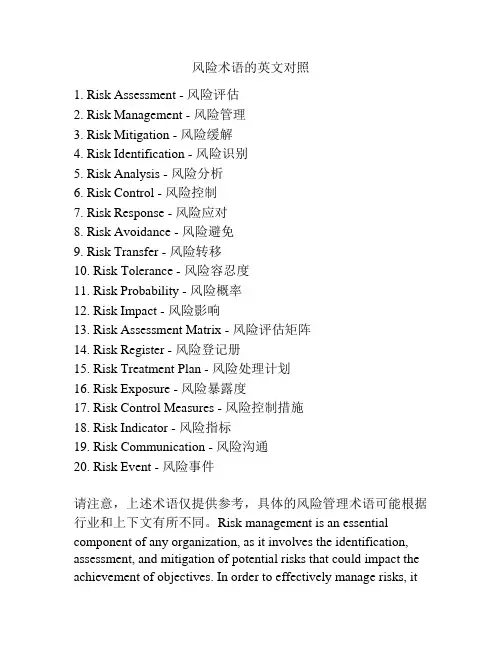
风险术语的英文对照1. Risk Assessment - 风险评估2. Risk Management - 风险管理3. Risk Mitigation - 风险缓解4. Risk Identification - 风险识别5. Risk Analysis - 风险分析6. Risk Control - 风险控制7. Risk Response - 风险应对8. Risk Avoidance - 风险避免9. Risk Transfer - 风险转移10. Risk Tolerance - 风险容忍度11. Risk Probability - 风险概率12. Risk Impact - 风险影响13. Risk Assessment Matrix - 风险评估矩阵14. Risk Register - 风险登记册15. Risk Treatment Plan - 风险处理计划16. Risk Exposure - 风险暴露度17. Risk Control Measures - 风险控制措施18. Risk Indicator - 风险指标19. Risk Communication - 风险沟通20. Risk Event - 风险事件请注意,上述术语仅提供参考,具体的风险管理术语可能根据行业和上下文有所不同。
Risk management is an essential component of any organization, as it involves the identification, assessment, and mitigation of potential risks that could impact the achievement of objectives. In order to effectively manage risks, itis crucial to have a clear understanding of various risk terminologies and their corresponding translations in English.Risk assessment, or 风险评估, is the process of identifying and evaluating potential risks to determine their likelihood and potential impact. This involves analyzing the probability of a risk occurring and assessing the potential consequences it could have on the organization. Risk assessments are typically conducted using various tools and techniques such as risk matrices, scenario analysis, and historical data.Once risks have been identified and assessed, the organization can proceed with risk management, or 风险管理. This involves developing strategies and action plans to minimize or eliminate the identified risks. Risk management aims to reduce the likelihood of a risk occurring or its potential impact if it does occur. It includes risk mitigation, or 风险缓解, which involves implementing measures to reduce the probability and/or severity of a risk.Risk identification, or 风险识别, is the process of identifying potential risks that could impact the organization's objectives. This includes analyzing internal and external factors that could lead to risks, such as changes in regulations, market volatility, or operational vulnerabilities. Risk analysis, or 风险分析, is the process of evaluating the identified risks to determine their potential impact and prioritize their treatment.Risk control, or 风险控制, involves implementing measures to reduce or manage the identified risks. This includes developingand implementing risk control measures, such as implementing safety protocols, conducting regular inspections, or implementing redundancy measures. Risk response, or 风险应对, refers to the actions taken by the organization to address identified risks. This could include accepting the risk, avoiding the risk, transferring the risk to a third party, or implementing measures to mitigate the risk.Risk avoidance, or 风险避免, refers to the strategy of completely eliminating the exposure to a particular risk. This could involve making changes to business processes, discontinuing certain activities, or avoiding certain markets or investments. Risk transfer, or 风险转移, involves transferring the responsibility and financial implications of a risk to another party, such as purchasing insurance coverage.Risk tolerance, or 风险容忍度, refers to the level of risk that an organization is willing to accept in order to achieve its objectives. This involves striking a balance between maximizing opportunities and minimizing potential risks. Risk probability, or 风险概率, refers to the likelihood or chance of a risk occurring. Risk impact, or 风险影响, refers to the magnitude of the consequences that would result if a risk were to occur.A risk assessment matrix, or 风险评估矩阵, is a tool used to evaluate and prioritize risks based on their likelihood and impact. It provides a visual representation of risks and helps in determining appropriate risk management strategies. A risk register, or 风险登记册, is a document that records all identified risks, along with their likelihood, potential impact, and mitigation measures.To implement effective risk management, organizations develop risk treatment plans, or 风险处理计划, which outline the specific actions to be taken to manage identified risks. These plans include a clear description of the risk, its potential impact, the desired risk treatment strategy, and the individuals responsible for its implementation.Risk exposure, or 风险暴露度, refers to the level of vulnerability or susceptibility of the organization to a particular risk. It considers the organization's potential financial, operational, and reputational losses resulting from a risk event. Risk control measures, or 风险控制措施, are actions implemented to mitigate or prevent identified risks. These measures may include implementing internal controls, conducting training programs, or investing in technologies to mitigate risks.Risk indicators, or 风险指标, are quantitative or qualitative measures used to monitor and assess risks. These indicators help in identifying early warning signs of emerging risks, enabling timely and proactive risk management. Risk communication, or 风险沟通, refers to the process of sharing information about risks within the organization or with external stakeholders. Effective risk communication is crucial for ensuring that everyone understands the risks, their potential impact, and the organization's strategiesfor managing them.Overall, understanding and utilizing risk terminologies in both English and their native language is vital for effective riskmanagement. It ensures clear communication, facilitates collaboration, and enhances the organization's ability to identify, assess, and mitigate risks. By effectively managing risks, organizations can safeguard their interests, minimize losses, and enhance their overall performance and resilience.。

epa评估方法EPA评估方法EPA(美国环境保护署)评估方法是一种用于评估环境影响和风险的科学方法。
它在环境保护领域得到广泛应用,用于评估化学品、污染物、废物和其他环境因素对人类健康和生态系统的潜在影响。
本文将介绍EPA评估方法的基本原理和应用。
一、EPA评估方法的基本原理EPA评估方法基于科学研究和风险评估的原则,通过收集、整理和分析大量的环境和健康数据,评估特定环境因素对人类和生态系统的潜在影响。
其基本原理包括以下几个方面:1. 数据收集和整理:EPA评估方法首先需要收集相关的环境数据和健康数据,包括化学物质的物理化学性质、毒性数据、环境浓度和暴露途径等。
同时,还需要收集人类健康效应和生态效应的相关数据。
2. 风险评估模型:EPA评估方法使用风险评估模型来分析环境因素对人类和生态系统的潜在影响。
这些模型基于流行病学、毒理学和环境科学等学科的知识,通过定量分析和预测来评估风险水平。
3. 不确定性分析:EPA评估方法还包括不确定性分析,用于评估评估结果的可靠性和确定性。
不确定性分析可以通过敏感性分析、模拟和统计方法等来进行。
二、EPA评估方法的应用EPA评估方法广泛应用于环境监测、风险评估和决策支持等领域。
其主要应用包括以下几个方面:1. 环境污染评估:EPA评估方法可以用于评估污染物对环境的潜在影响。
通过收集环境数据和污染物的毒性数据,结合风险评估模型,可以评估污染物的暴露水平和潜在风险。
2. 化学品评估:EPA评估方法可以用于评估化学品对人类健康和环境的潜在影响。
通过收集化学品的物理化学性质、毒性数据和暴露途径等信息,结合风险评估模型,可以评估化学品的致癌、致畸和致突变等潜在风险。
3. 废物管理评估:EPA评估方法可以用于评估废物对环境和人类健康的潜在影响。
通过收集废物的组成、毒性数据和处理方式等信息,结合风险评估模型,可以评估废物的处理风险和环境影响。
4. 环境政策制定:EPA评估方法可以用于支持环境政策的制定和实施。
根据CAC工作程序手册(1997年,第10版),与食品安全有关的风险分析术语的定义如下,需要说明的是,风险分析是一个正在发展中的理论体系,因此有关术语及其定义也在不断地修改和完善。
危害(hazard):潜在的将对消费者健康造成不良效果(事件)的生物、化学或物理因素。
风险(risk):将对人体健康或环境产生不良效果的可能性和严重性,这种不良效果是由食品中的一种危害所引起的。
风险源(risk source):具有潜在的引发不良效果的药剂、媒介物、商业/工业加工过程、加工步骤或加工场地。
风险分析(risk analysis):指对可能存在的危害的预测,并在此基础上采取的规避或降低危害影响的措施。
由风险评估、风险管理和风险交流三部分共同构成的一个过程。
危害评估(hazard assessment):某一种食品中的某一大类危害物作为评估对象,找出显著的需要进行风险评估的对象,确定风险评估的范围。
风险评估(risk assessment):一个包括在特定条件下,风险源暴露时将对人体健康和环境产生不良效果的事件发生可能性的评估,此风险评估过程包括:危害识别、危害描述、暴露评估、风险描述。
危害识别(hazard identification):识别可能对人体健康和环境产生不良效果的风险源,可能存在于某种或某类特别食品中的生物、化学和物理因素,并对其特性进行定性描述。
危害描述(hazard characterization):对与食品中可能存在的生物、化学和物理因素有关的健康不良效果的对人体健康和环境产生不良效果风险源的定性和/或定量评价。
对化学因素应进行剂量-反应评估。
对生物或物理因素,如数据可得到时,应进行剂量-反应评估。
剂量-反应评估(dose-response assessment):确定某种风险源的暴露水平(剂量)与相应的不良效果的严重程度/或发生频度(反应)之间的关系。
暴露评估(exposure assessment):可能通过一种或多种途径暴露到人体和/或环境的风险源的定量或定性评估。
危险化学品的性评估模型与软件在化学品的生产和使用过程中,一些化学品可能会带来潜在的危险和风险。
因此,评估危险化学品的性质和对人类健康及环境的影响变得至关重要。
为了更好地评估和管理危险化学品,我们需要可靠的性评估模型和软件来帮助我们进行分析和预测。
本文将介绍一些常用的危险化学品性评估模型与软件,并探讨其在实际应用中的作用。
一、危险化学品性评估模型1. QSAR模型定量构效关系(Quantitative Structure-Activity Relationship, QSAR)模型是一种基于化学结构与活性关系的模型,广泛应用于危险化学品的性评估中。
通过分析化学结构和实验数据之间的关联,QSAR模型可以预测化学品的毒性、生态和环境行为等方面的信息。
经过训练和验证,QSAR模型可以为决策者提供较为准确的评估结果。
2. PBPK模型生物动力学-生物转化模型(Pharmacokinetic-Pharmacodynamic, PBPK)是一种综合考虑化学品在生物体内代谢、吸收、分布和排泄等过程的模型。
通过建立化学品在生物体内的动力学模型,PBPK模型可以预测化学品在人体内的浓度和潜在的毒性效应。
PBPK模型的应用可以为风险评估和人群暴露研究提供重要依据。
二、危险化学品性评估软件1. EpiSuite软件EpiSuite是由美国环境保护署(EPA)开发的一套危险化学品性评估软件。
该软件包括了一系列的模型和数据库,可用于预测化学品的理化性质、毒性和生物降解等信息。
EpiSuite软件提供了直观、易于使用的界面,使用户能够快速进行危险性评估和风险管理。
2. ToxTree软件ToxTree是一个开源的化学品分类和模型软件,主要用于替代动物试验和预测化学品的毒性。
通过结合不同的决策规则和模型,ToxTree软件可以根据化学品的结构和特性对其进行分类,并预测潜在的毒性。
该软件具有良好的灵活性和可扩展性,可适应不同化学品的评估需求。
化学污染物摄入量一般计算公式:1C CR EFD I BW AT⨯⨯=⨯I —— 摄入量, 在交接面的化学物质量 (mg/kg .day )C = 化学浓度; 在暴露期间接触过程中的平均浓度(mg/L )CR = 接触速率; 单位时间或单位事件中接触的有害介质的量(L/day )EFD = 暴露频率及时长;描述暴露发生的时间与频率。
一般采用两种方式计算:EF —— 暴露频率(天/年);ED —— 暴露时长(年)BW = 体重; 暴露发生期间的平均体重(kg )AT = 平均时间; 平均暴露时间段(天)饮用水(饮用水制作的饮料)中的化学物质消化摄入量计算1CW IR EF ED BW AT⨯⨯⨯•=⨯摄入量(mg/kg day )CW = 水体中的化学浓度(mg/L );IR = 消化速率(L/day );EF = 暴露频率(days/year );ED = 暴露持续时间(years );BW = 体重(kg );AT = 平均时间 (平均的暴露时间—days );CW : 特殊场地测量值或者模式值IR :2 L/day (90% 成年人,来自EPA 数据)1.4 L/day (成年人,平均数,EPA)特殊年龄数值EF : 特殊暴露途径值 (普通居民,常为 365 days/year )ED: 70 年(按惯例,人平均一生时间)30年 (国家单个居民上限值(90%),EPA )9年(国家单个居民一般时间(50%),EPA )BW : 70kg (平均成年人,EPA )特殊年龄数值(EPA )AT : 非致癌效应通过特殊途径暴露的是时间段 (如:ED ⨯365 days/year ),或者一生70年致癌效应时间(70 years ⨯ 365 days/year )地表水中游泳过程消化摄入化学物质计算公式:CW CR ET EF ED BW AT⨯⨯⨯⨯•=⨯摄入量(mg/kg day )CW = 水体中的化学浓度(mg/L );CR = 接触速率 (L/ h )ET = 暴露时间(h /event );EF = 暴露频率(days/year );ED = 暴露持续时间(years ); BW = 体重(kg );AT = 平均时间 (平均的暴露时间—days );CW : 特殊场地测量值或者模式值CR: 50 ml/h ( EPA )ET: 特殊途径值EF : 特殊途径值(考虑当地气候情况(如:高于给定温度的天数) 和潜在暴露人群的年龄)7 days/year (游泳的年平均值,USDOI, EPA)ED: 70 年(按惯例,人平均一生时间)30年 (国家单个居民上限值(90%),EPA )9年(国家单个居民一般时间(50%),EPA )BW : 70kg (平均成年人,EPA )特殊年龄数值(EPA )AT : 非致癌效应通过特殊途径暴露的是时间段 (如:ED ⨯365 days/year ),或者一生70年致癌效应时间(70 years ⨯ 365 days/year )水中化学物质皮肤接触吸入量计算公式: CW SA PC ET EF ED CFBW AT ⨯⨯⨯⨯⨯⨯•=⨯吸收量(mg/kg day )CW = 水体中的化学浓度(mg/L );SA = 有效接触的皮肤表面积 (cm 2);PC = 特殊化学品皮肤渗透率 (cm/hr );ET = 暴露时间(h /event );EF = 暴露频率(days/year );ED = 暴露持续时间(years );CF = 水体积转换系数 (1L/1000 cm 3)BW = 体重(kg );AT = 平均时间 (平均的暴露时间—days );CW: 特殊场地测量值或模式值SA :PC: 查阅相关文献(注:只在此公式中使用此参数)ET :特殊途径参数(如果信息可得,需考虑当地活动模式)2.6 hrs/day (游泳国家平均值, USDOI EPA)EF:特殊途径值(考虑当地气候情况(如:高于给定温度的天数)和潜在暴露人群的年龄)7 days/year (游泳的年平均值,USDOI, EPA)ED: 70 年(按惯例,人平均一生时间)30年(国家单个居民上限值(90%),EPA)9年(国家单个居民一般时间(50%),EPA)CF:1 L/1000 cm3BW:70kg (平均成年人,EPA)特殊年龄数值(EPA)AT:非致癌效应通过特殊途径暴露的是时间段(如:ED⨯365 days/year),或者一生70年致癌效应时间(70 years ⨯365 days/year)CS IR CF FI EF ED BW AT⨯⨯⨯⨯⨯•=⨯吸收量(mg/kg day )CS = 土壤中的化学物质浓度 (mg/kg );IR = 消化速率 (mg 土/day )CF = 转换系数 (10 -6 kg/mg );FI = 污染源摄入分数 (无量纲);EF = 暴露频率 (days/years );ED = 暴露持续时间(years );BW = 体重(kg );AT = 平均时间 (平均的暴露时间—days );CS : 场地测量值IR : 200mg/day (儿童,1~6岁,EPA)100mg/day(大于6岁,EPA)注: IR 值为默认值并且应根据场地实际情况和其他资料进行调整。
国际安全风险评估模型
国际安全风险评估模型是一个用于评估国际安全风险的工具或方法。
它通常基于一系列参数和指标,包括地理、政治、经济、军事、社会和环境等因素。
根据这些因素的不同权重和组合,可以对不同国家或地区进行安全风险评估。
国际安全风险评估模型通常由地理信息系统(GIS)、数据分
析和统计模型、专家意见等多种方法相结合。
通过收集和分析相关数据,评估模型可以量化风险,并产生可视化的结果,以帮助决策者和利益相关者了解和管理国际安全风险。
评估模型通常可以用于预测和防范各种国际安全风险,如恐怖主义、战争、内战、政治动荡、自然灾害、流行病等。
它可以帮助决策者制定安全政策、规划资源分配、制定危机管理策略等。
然而,国际安全风险评估模型也存在一些局限性。
首先,数据的可靠性和有效性可能会影响评估结果的准确性。
其次,模型无法考虑到一些不确定因素和意外事件的影响。
最后,评估结果仍然需要人工解读和决策。
因此,在使用国际安全风险评估模型时,需要综合考虑多个因素,并结合其他情报和专家意见进行综合分析。
同时,定期更新模型和数据,以适应不断变化的国际安全环境。
英语信用风险专业术语 Revised by Jack on December 14,2020SWOT分析(SWOT analysis)——分析经营风险的方法。
即对企业的优势(strengths)、弱点(weaknesses)、机会(opportunities)、威胁(threats)列表分析。
Z值(Z Score)——指对企业财务状况、破产可能性的量化评估。
Z值主要利用核心的财务指标进行评估,它是由企业破产预测模型得出。
Z值模型(Z score models)——用少量关键指标衡量企业破产风险的模型。
每一个z值模型都有自己的关键指标。
不同的z值模型适用于不同的行业和不同的国家。
巴塞尔协议(Basle Agreement)——由各国中央银行、国际清算银行成员签订的国际协议,主要是关于银行最小资本充足的要求。
它也被称为BIS规则(BIS rules)。
保兑信用证(Confirmed Letter of Credit)——开出信用证的银行和第二家承兑的银行都承诺有条件地担保支付的信用证。
保留所有权的条款(Retention of Title Clause)——销售合同中注明,供应商在法律上拥有货物的所有权,直到顾客支付了货款的条款。
保证契约(Covenant)——借款人承诺遵循借款条约的书面文件,一旦借款人违背了契约书的规定,银行有权惩罚借款人。
本票(Promissory Note)——承诺在指定的日期支付约定金额的票据。
边际贷款(Marginal Lending)——新增贷款。
可以指对现有客户增加的贷款,也可指对新客户的贷款。
边际客户(Marginal Customer)——指额外的客户。
寻求成长机会的企业会尽力将产品销售给新客户,而且通常是不同种类的客户。
这些新增客户的信用风险可能比企业现有的客户要高。
财产转换贷款(Asset Conversion Loan)——用于短期融资的短期贷款,例如,季节性的筹集营运资金。
制药工程常用英文缩写,缩略语1GMP Good Manufacturing Practices药品生产质量管理规范2GxP各种药品规范的统称3GCP Good Clinical Practice药物临床试验质量管理规范4GLP Good Laboratory Practice药物非临床试验(实验室)质量管理规范5GSPGDPGood Supplg practiceGood Distribute Practice(美)药品经营质量管理规范6GDP Good Dossier practice申报资料质量管理规范7GPP Good Pharmacy practice药房质量管理规范8GQP Good Quality Practice 药品质量管理规范9GRP Good Rearch Practice药品研究质量管理规范10GUPGPPGood Use PracticeGood Preparation Practice(欧美)药品使用质量管理规范11GVP Good Validation Practice验证管理规范12GAP Good Agricultural Practice中药材生产质量管理规范13GEP Good Engineering Practice工程管理规范14GWP Good Warehousing Practice药品仓储规范15GMPC Good Manufacture Practice of Cosmetic Products 化学品生产质量管理规范16cGMP Current Good Manufacturing Practice现行药品生产质量管理规范17EU-GMP European –Good Manufacturing Practice欧洲GMP18CFR Code of Federal Regulations美国联邦法规19ChP Chinese Pharmacopoeia中国药典20USP United States Pharmacopoeia美国药典21EP European Pharmacopoeia欧洲药典22JP Japanese Pharmacopoeia日本药典23BP British Pharmacopoeia英国药典24IP Indian Pharmacopoeia印度药典25EN European Norm欧洲规范,欧洲标准26ANSI American National Standards Institute美国国家标准学会27ASME American Society of Mechanical Engineers美国机械工程师学会28ASTM American Society for Testing and Materials美国材料实验学会29ISPE International Society for Pharmaceutical Engineering 国际制药工程学会30WHO World Health Organization世界卫生组织31ISO International Standards Organization国际标准组织32EEC European Economic Community欧洲共同体、欧共体33EU European Union欧盟34ES European Commission欧洲委员会35CFDA China Food and Drug Administration中国食品和药品监督管理局36FDA Food and Drug Administration(美国)食品和药品管理局37MHRA Medicines & Healthcare Products Regulatory Agency(英国)药品和健康产品管理局38EHX Environment Health Safety环境、职业健康、安全管理体系39BPE Bioprocessing Equipment生物处理设备403A美国卫生行业协会、美国卫生论证标识41NBST National Bureau of Standards and Technology美国国家标准研究院42EMA European Medicines Agency欧洲药监局43EMEA European Agency for the evaluationof medicinal欧洲药品评价局44EDQM European Directorate for the Quality of Medicines 欧洲药品理事会45EQDM European Directorate for the Quality of Medicines & Healthcare欧洲药品与健康理事会46EHEDG European Hygienic Equipment Design Group欧洲卫生设备设计组织47ICH International Conference on Harmonization of TechnicalRequirements for Registration of Pharmaceuticals for Human 人用药物注册技术要求国际协调会议48IEC International Electrotechnical Commission国际电工委员会通用及组织49NEMA National Electrical Manufacturers Association美国电器制造商协会50CEP Certificate of Suitability for European Pharmacopeia欧洲药典适用性证书51CE Conformite Europeenne 欧洲电气安全论证52PIC/S Pharmaceutical Inspection ConventionPharmaceutical Inspection Cooperation Scheme国际医药品稽查协约组织53HHS United States Department of Health and Human Services美国卫生及公共服务部、美国卫生部54PDA Parenteral Drug Association(美国)注射剂协会55EPA Environmental Protection Agency(美国国家)环境保护局56CDER Center for Drug Evaluation and Research药物评价与研究中心57MHWMHLWMinistry of Health and WelfareMinistry of Health, Labor and Welfare(日本)厚生省(日本)厚生劳动省5821 CFR Title 21―Food and Drugs美国联邦法规,第21篇,食品与药品59Part11Electronic Records; Electronic Signatures第11节,电子记录与电子签名60Part210Current Good Manufacturing Practice in Manufacturing,Processing,Packing,or Holding of Drugs;General第210节,药品生产、加工、包装、储存质量规范部分61Part211Current Good Manufacturing Practice for Finished 第211节,制剂药物生产质量规范部分62Part314Applications for FDA Approval to Market a New Drug第314节,新药上市申请部分63Part320Bioavailability and Bioequivalence Requirements 第320节,生物利用度和等效性要求1QMS Quality Management System质量管理体系2QRS Quality Regulation System质量控制体系3QA Quality Assurance质量保证4QC Quality Control质量控制5QM Quality Management质量管理6QI Quality Inspection质量检验7QP Quality Plan质量计划8QRM Quality Risk Management质量风险管理9URS User Requirement Specification用户需求10DQ Design Qualification设计确认11IQ Installation Qualification安装确认12OQ Operational Qualification操作确认13PQ Performance Qualification性能确认14VIT Vendor Internal Test供应商内部测试15FAT Factory Acceptance Test工厂验收测试16SAT Site Acceptance Test现场验收测试17SOP Standard of Operation标准操作规程18FDS Functional and Design Specifications功能设计说明、功能设计规范19FS Functional Specifications功能说明20DS Design Specifications设计说明21TS Technical Specification技术说明、技术规范22RTM(TM)Requirement Traceability Matrix需求追溯矩阵23ITR Inspection T est Reports检查测试报告24QOR Quality Observation Report质量检查报告25QR Quality Requirements质量要求26QR Quality Records质量记录27RA Risk Assessment风险评估28SIA System Impact Assessment系统影响性评估29CCA CriticalComponents Assessment部件关键性评估30PV Process Validation工艺验证31CV Cleaning Validation清洁验证32CSV Computer System Validation计算机验证33VMP Validation Master Plan 验证主计划质量、验证34VP Validation Plan 验证计划35VP Validation Protocol验证方案36VR Validation Report验证报告37PVP Project Validation Plan项目验证计划38PVR Project Validation Report项目验证报告39QbD Quality by Design质量源于设计40DMF Drug Master File药品主文件、药物管理档案41FMEA Failure Mode and Effects Analysis失效模式和效果分析42SST System Suitability Test系统适应性测试43CAL Calibration校验、校准44CAPA Corrective Action and Preventive Action纠正预防措施45RCA Root Cause Analysis根本原因分析46ERES Electronic Record and Electronic Signature电子记录与电子签名47AQL Acceptable Quality Level可接受质量水平48CQA Critical Quality Attribut关键质量属性49CPP Critical Process Pararneter关键工艺参数50CTD Common T echnical Document通用技术文件51IA Impact Assessment影响评估52PQR Procut Quality Review产品质量回顾53COA Certification of Analysis分析合格证书、检验报告54BPR Batch Production Records批生产记录55BR Batch Records批记录56CC Change Control变更控制57DR Deviation Records偏差记录58COM Commissioning试车59BAR Batch Analysis Record批检验记录60PP Process Procedure工艺规程61OOS Out of Specification超出标准(限度)62LAL Limulus Smoebocyte Lysate鲎试剂63AQL Acceptable Quality Level可接受质量水平64SMF Site Master File工厂主文件65PM Preventive Maintenance预防性维修66QP Qualified Person质量授权人67R&D Research and Development研发部门68NDA New Drug Application新药申请电气及自控1GAMP Good Automated Manufacturing Practices设备自动化生产管理规范2HMI Human Machine Interface人机界面3OIT Operator Interface Terminals操作员界面终端4OIP Operator Interface Panel操作员界面面板5PLC Programmable Logic Controller可编程序控制器6PCS Process Control System过程控制系统7DCS Distributed Control System集散控制系统8PCS Process Control System工艺控制系统9DDC Direct Digital Controller直接数字控制器10IPC Industrial Personal Computer工业控制计算机,工控机11PAC Programmable Automation Controller可编程自动化控制器12PCC programmable computer controller可编程计算机控制器13MCU Microcontroller Unit单片机14CPU Central Process Unit中央处理器15PC Personal Computer个人电脑16SCADA Supervisory Control And Data Acquisition监控及数据采集17SDS Software design specification软件设计说明18HDS Hardware Design Specification硬件设计说明19FL Functional Logic功能逻辑说明20I/O Input / Output输入/输出21AI Analog Input模拟量输入22AO Analog Output模拟量输出23DI Digital Input数字量输入24DO Digital Output数字量输出25RTD Resistance Temperature Detector热电阻26T/C Thermocouple热电偶27RTU Remote Terminal Unit远程终端单元28ARS Automation Requirement Specification自动化需求规范29VFD Variable Frequency Drive变频驱动30EMC Electromagnetic Compatibility电磁兼容31UPS Uninterrupted Power supply不间断电源32EPS Emergency Power supply应急电源33FL Functional Logic功能逻辑说明34ER and Electronic Signature电子记录35ES Electronic Signature电子签名36AT Audit Trail审计踪迹37NO Normally Open常开38NC Normally Close常关39FO Fault Open故障开40FC Fault Close故障关41AC Alternating Current交流42DC Direct Current直流43PID Proportional Integral Derivative比例积分微分44LED Light Emitting Diode发光二极管45LCD Liquid Crystal Display液晶显示器46LIMS Laboratory Information Management System实验室信息管理系统 47LECP Laboratory Equipment Calibration Program 实验室仪器校准程序48WMS Warehouse Management System仓库管理系统49MES Manufacturing Execution System制造执行系统50ERP Enterprise Resource Planning企业资源计划其它1N/A Not Applicable不适用2NLT Not Less Than不少于3NMT Not More Than不多于4NB Nominal Bore公称管径5PED Pressure Equipment Directive压力设备指令(欧洲) 6PW Purified Water纯化水7WFI Water for Injections注射用水8PS Pure Steam纯蒸汽发生器9PWG PW Generator Unit纯化水制备机组10WFIG WFI Generator注射用水制备机组11MEWD Multi-effect Water Distillator 多效蒸馏水机12PSG PS Generator纯蒸汽发生器13PAC Poly Alumina Chlorine聚合氯化铝14DW Demineralized Water脱盐水,去离子水15MF Micro-Filter微滤16UF Ultra-Filter 超滤17NF Nano-Filter纳滤18MMF Multi-Media Filter多介质过滤器19ACF Activated Carbon Filter活性炭过滤器20SF Softener软化器21DG Degasifier脱气塔22RO Reverse Osmosis 反渗透23EDI Electrodeionization电法去离子24MB Mixed Bed混床25MDG Membrane Degasifier膜脱气26COP Clean out Place离线清洗27CEB Chemical Enhanced Backwash化学增强反冲洗28CIP Clean In Place在线清洗29SIP Sterilization in Place在线灭菌30POU Point Of Use使用点31PH Potential of Hydrogen酸碱度32TOC Total Organic Carbon总有机碳33ORP Oxidation-Reduction Potential氧化还原电位34COD Chemical Oxygen Demand化学耗氧量35BOD Biological Oxygen Demand生物耗氧量36SDI Silt Density Index污染密度指数37TUB Turbidity浊度38TSS Suspended Solid总悬浮固体39DO Dissoved Cxygn溶解氧40TDS Total dissolved solids总溶解固体41TH Total Hardness总硬度42PAT Process Analytical & Measurement T echnology过程分析技术43IRS Installation Requirement Specification安装要求说明44OEM Original Equipment Manufacturer 原始设备制造商45GDS General Design Specification总体设计说明46DDS Detailed Design Specification详细设计说明47PCP Preparation of Construction Plan施工组织设计48WMS Work Method Statement施工方案49BOQ Bill of Quantities工程量清单50BOM Bill of Material材料清单51P&ID Process and Instrumentation Diagram工艺与仪表流程图52PFD Process Flow Diagram工艺流程示意图53ANDA Abbreviation New Drug Application仿制药或仿制新药申请54OPQ Operational Personnel Qualification操作人员资格鉴定55MBT Microbiologic Test微生物测定56ADR Adverse Drug Reaction药物副作用报告,药品不良报告57OMM Operating and Maintenance Manual操作和维护保养手册58HACCP Hazard Analysis and Critical Control Point危害分析及关键环节控制点59CCP Critical Control Point关键环节控制点60IPC In Process Control过程控制61IPC Intermediate Production Control中间生产控制62CIPC Critical In-Process Control关键中间控制点63MBR Master Batch Record主生产批记录64PPM Parts Per Million百万分之一65OC Organizational Charts组织结构图66FIT Filter Integrity Test过滤器完整性测试67WIT Water Intergrity Test水侵入测试68GA General Arrangement总平面图69RPM Rotations per minute转/分70PD Prescription Drug处方药71Rx Receptor x处方药72NPD Nonprescription Drug非处方药73OTC Over The Counter非处方药74API Active Pharmaceutical Ingredient原料药、活性药75BPC Bulk Pharmaceutical Chemical原料药(原简称)76DS Drug Substance原料药77DP Drug Product成品药78RO Restriction orifice限流孔板79SG Sight Glass视镜80LG Lamp Glass,Light Glass灯镜81RD Rupture Disk爆破片材料1MOC Material Of Construction建造材质2SS Stainless Steel不锈钢3CI Cast iron铸铁4NCI Nodular east iron球墨铸铁5CS Carbon Steel碳钢6 C.Stl Cast Steel铸钢7 F.Stl Freezing Steel锻钢8PA Polyamide聚酰胺9PB Polybutylene聚丁烯10PC Polycarbonate聚碳酸酯11PE Polyethylene聚乙烯12PEX Cross-linked PolyEthylene交联聚乙烯13HDPE High-density polyethylene plastics高密度聚乙烯14MDPE Medium-density polyethylene plastics中密度聚乙烯15PO Polyolefin聚烯烃16PP Polypropylens聚丙烯17FRPP Polypropylens玻纤增强聚丙烯18PPR Polypropyla无规共聚聚丙烯19PPS PolyPhenylene Sulfide聚苯硫醚20PS Polystrene聚苯乙烯21PU Polyurethane,或者缩写为PUR聚氨酯22POM PolyOxyMethylene or Polyacetal聚甲醛,聚氧化亚甲基23HIPS High impact polystyrene高抗冲聚苯乙烯26PFA Polyfluoroalkoxy四氟乙烯—全氟烷氧基乙烯基醚共聚物27PTFE Polytetrafluoroethylene聚四氟乙烯28PVDF Poly vinylidene fluofide聚偏二氟乙烯29PVC Polyvinyl chloride聚氯乙烯30UPVC Unplasticised Polyvinyl Chloride硬聚氯乙烯,增强聚氯乙烯31CPVC Chlorinated polyvinyl chloride,或者缩写为PVCC氯化聚氯乙烯32PA Nylon,Polyamide尼龙,聚酰胺33PES PolyEtherSulfone聚醚砜,聚酯34AAS Acrylonirile butadiene styrene丙烯腈-丙烯酸酌-苯乙烯35ABS Acrylonitrile-Butadiene-Styrene丙烯腈-丁二烯-苯乙烯共聚物36ACS Acrylonitrile Chlorinated polyethylene Styrene丙烯胯-氯化聚乙烯-苯乙烯37ASB Asbestos石棉38PMMA Polymethel methacrylate聚甲基丙烯酸甲酯39SR Styrene-rubber苯乙烯橡胶24EPDM Ethylene Propylene Diene Monomer三元乙丙橡胶25EPM Ethylene Propylene Methylene乙丙橡胶,乙烯/丙烯共聚物40SR Silicone rubber硅橡胶40HTV High Temperature Vulcanization高温硫化(硅橡胶)40RTV Room Temperature Vulcanization室温硫化(硅橡胶)40MQ Silicone rubber甲基硅橡胶40VMQ Silicone rubber甲基乙烯基硅橡胶40PVMQ Silicone rubber甲基乙烯基苯基硅橡胶41FPMFKMFluororubberFluorocarbon Rubber氟橡胶42NBR Vulcanized nitrile rubber丁腈橡胶43FRP Glass Fibre Reinforced Plastic玻璃钢,玻璃纤维增强塑料1HVAC Heating Ventilation and Conditioning供热通风空调2AC Air Conditioner空调3AHU Air Handling Unit空气处理单元4BMS Building Monitoring System建筑管理系统、楼宇检测系统5CFU Colony Forming Unit菌落形成单位6CNC Controlled Non-Classified控制但未分级7FFU Fan Filter Unit风机过滤单元8FMS Factory Monitoring System车间监控系统9HEPA High Efficiency Particulate Air高效空气过滤器10LAF Laminar Air Flow层流、单向流11UDF Unidirectional Flow单向流12RABS Restricted Access Barrier Systems限制通过隔离系统13DP Differential Pressure压差14SDP Static Differential Pressure静压差15RH Relative Humidity相对湿度16CHWs Chilled Water (Supply)冷冻水(供给)17CWr Cooling Water (Return)冷却水(回流)18HW Hot Water热水19FS Factory Steam工厂蒸汽20SC Steam Condensate蒸汽冷凝水21WD Waste Drain废水排放22PWW Process Wastewater工艺污水23CA Compressed Air压缩空气24PA Process Air工艺压缩空气25IA Instrument Air仪表压缩空气26RW Raw Water原水27SW Soft Water软水28MW Middle Water中水29DW Domestic Water生活用水30CW City Water市政供水、自来水31DK Drinking Wat 饮用水32LPG Liquefied Petroleum Gas液化石油气33LNG Liquefied Natural Gas液化天然气34CNG Compressed natural gas压缩天然气35VE Visual Examination外观检查36UT Ultrasonic inspection Test超声探伤37RT Radiographic inspection Test射线探伤38MT Magnetic particle inspection Test磁粉探伤39PT liquid Penterant inspection Test液体渗透探伤40AutoclaveSterilizer灭菌柜公用工程41FBD Fluid Bed Dryer流化床42BFS Blowing Filling and Sealing吹灌封43HPLC High Pressure Liquid Chromatograph高效液相色谱44TLC Thin Layer Chromatograph薄层色谱45GC Gas Chromatograph气相色谱46UV Ultra-Violet紫外线47IR InfraRed红外线48RFQ Request for Quotations报价征询书49NPT American standard taper pipe thread美国标准锥管螺纹50NPS American standard straight pipe thread美国标准直管螺纹51NF American national fine thread美国标准细牙螺纹52NC American national coarse thread美国标准粗牙螺纹53Union Union 活接头,由宁。